1994 CHEVROLET CORVETTE cooling
[x] Cancel search: coolingPage 107 of 274
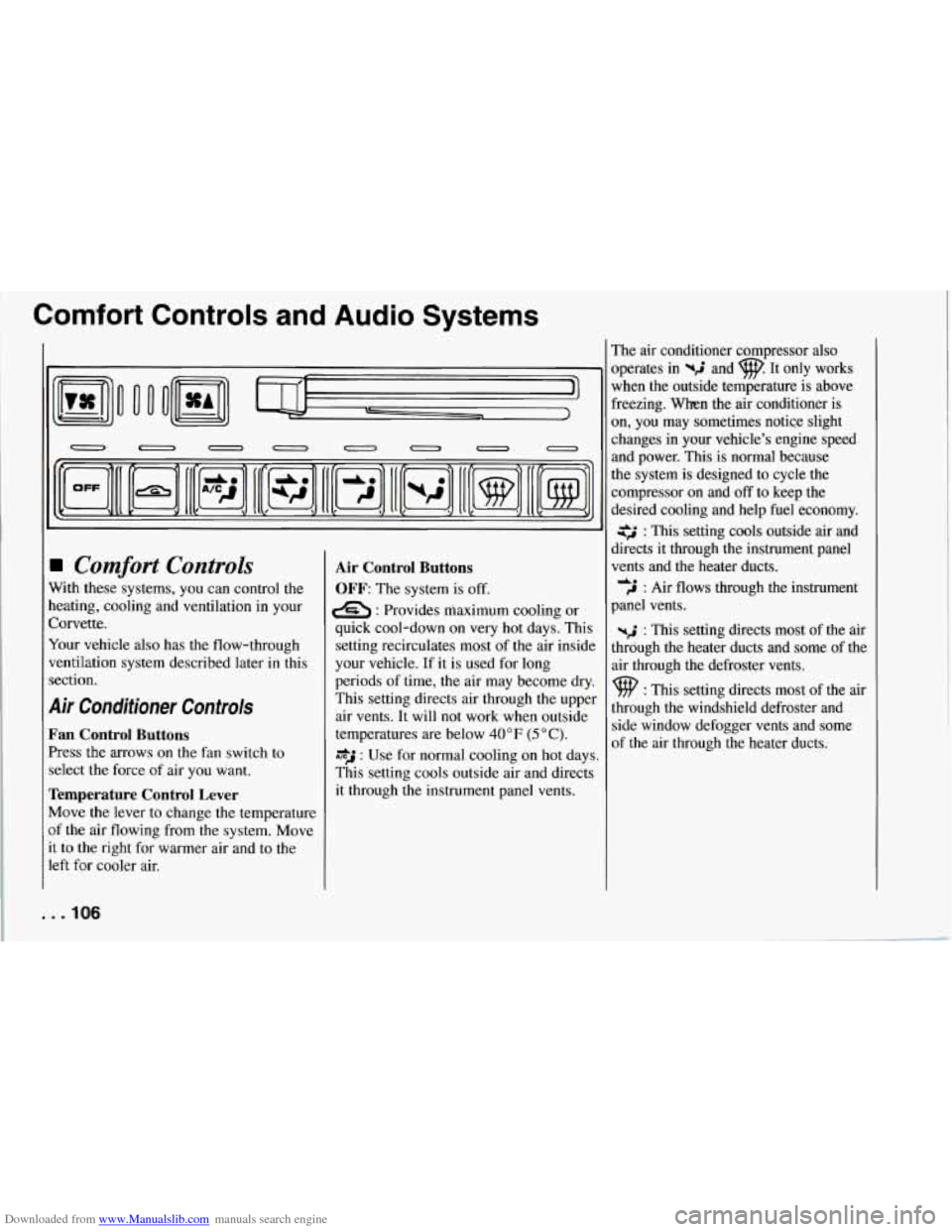
Downloaded from www.Manualslib.com manuals search engine Comfort Controls and Audio Systems
0 00
0 0 0 0 0 0 0 a
Comfort Controls
With these systems, you can control the
heating, cooling and ventilation in your
Corvette.
Your vehicle also has
the flow-through
ventilation system described later in this
section.
Air Conditioner Controls
Fan Control Buttons
Press the arrows on the fan switch to
select the force of air you want.
Temperature Control Lever
Move the lever to change the temperature
of the air flowing from
the system. Move
it to the right for warmer air and to the
left for cooler air.
Air Control Buttons
OFF: The system is off.
e : Provides maximum cooling or
quick cool-down on very hot days. This
setting recirculates most of the air inside
your vehicle. If it is used for long
periods of time,
the air may become dry.
This setting directs air through the upper
air vents. It will not work when outside
temperatures are below
40 OF (5 O C).
*J : Use for normal cooling on hot days.
This setting cools outside air and directs
it through the instrument panel vents. The air conditioner compressor also
operates in
%$ and w. It only works
when the outside temperature is above
freezing. When the air conditioner is
on, you may sometimes notice slight
changes
in your vehicle’s engine speed
and power. This is normal because
the system is designed to cycle the
compressor on and
off to keep the
desired cooling and help fuel economy.
: This setting cools outside air and
directs it through the instrument panel
vents and the heater ducts.
,J : Air flows through the instrument
panel vents.
-2 : This setting directs most of the air
through the heater ducts and some of the
air through the defroster vents.
9 : This setting directs most of the air
through the windshield defroster and
side window defogger vents and some
of the air through the heater ducts.
de
. . .IO6
Page 108 of 274
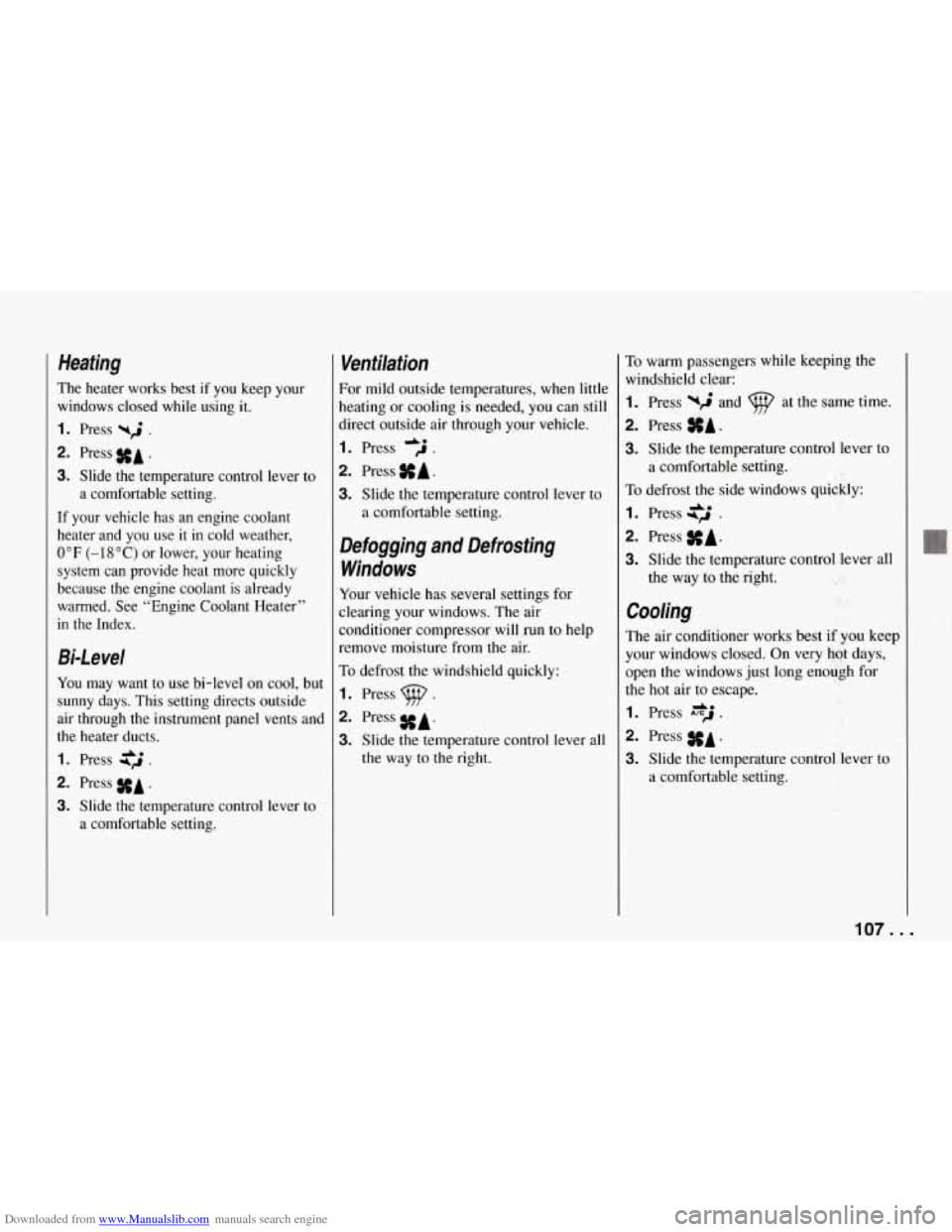
Downloaded from www.Manualslib.com manuals search engine Heating
The heater works best if you keep your
windows closed while using it.
1. Press yri .
2. Press #A .
3. Slide the temperature control lever to
If your vehicle has an engine coolant
heater and you use it in cold weather,
0°F (-18°C) or lower, your heating
system can provide heat more quickly
because the engine coolant is already
warmed. See “Engine Coolant Heater”
in the Index. a comfortable setting.
Bi-Level
You may want
to use bi-level on cool, but
sunny days. This setting directs outside
air through the instrument panel vents and
the heater ducts.
1. Press $2 .
2. Press #A .
3. Slide the temperature control lever to
a comfortable setting.
Ventilation
For mild outside temperatures, when little
heating or cooling is needed, you can still
direct outside air through your vehicle.
I. Press .
2. Press SA.
3. Slide the temperature control lever to
a comfortable setting.
Defogging and Defrosting
Windows
Your vehicle has several settings for
Aearing your windows. The air
Zonditioner compressor will
run to help
remove moisture from the air.
To defrost the windshield quickly:
I. Press p .
2. Press SA.
3. Slide the temperature control lever all
the way to the right.
To warm passengers while keeping the
windshield clear:
1. Press wd and at the same time.
2. Press SA.
3. Slide the temperature control lever to
To defrost the side windows quickly:
I. Press .
2. Press SA.
3. Slide the temperature control lever all
a
comfortable setting.
the way to the right.
Cooling
The air conditioner works best if you keep
your windows closed. On very hot days,
,pen the windows just long enou,gh for
:he hot air to escape.
I. Press A*J .
2. Press SA.
3. Slide the temperature control lever to
a comfortable setting.
107. I
Page 109 of 274
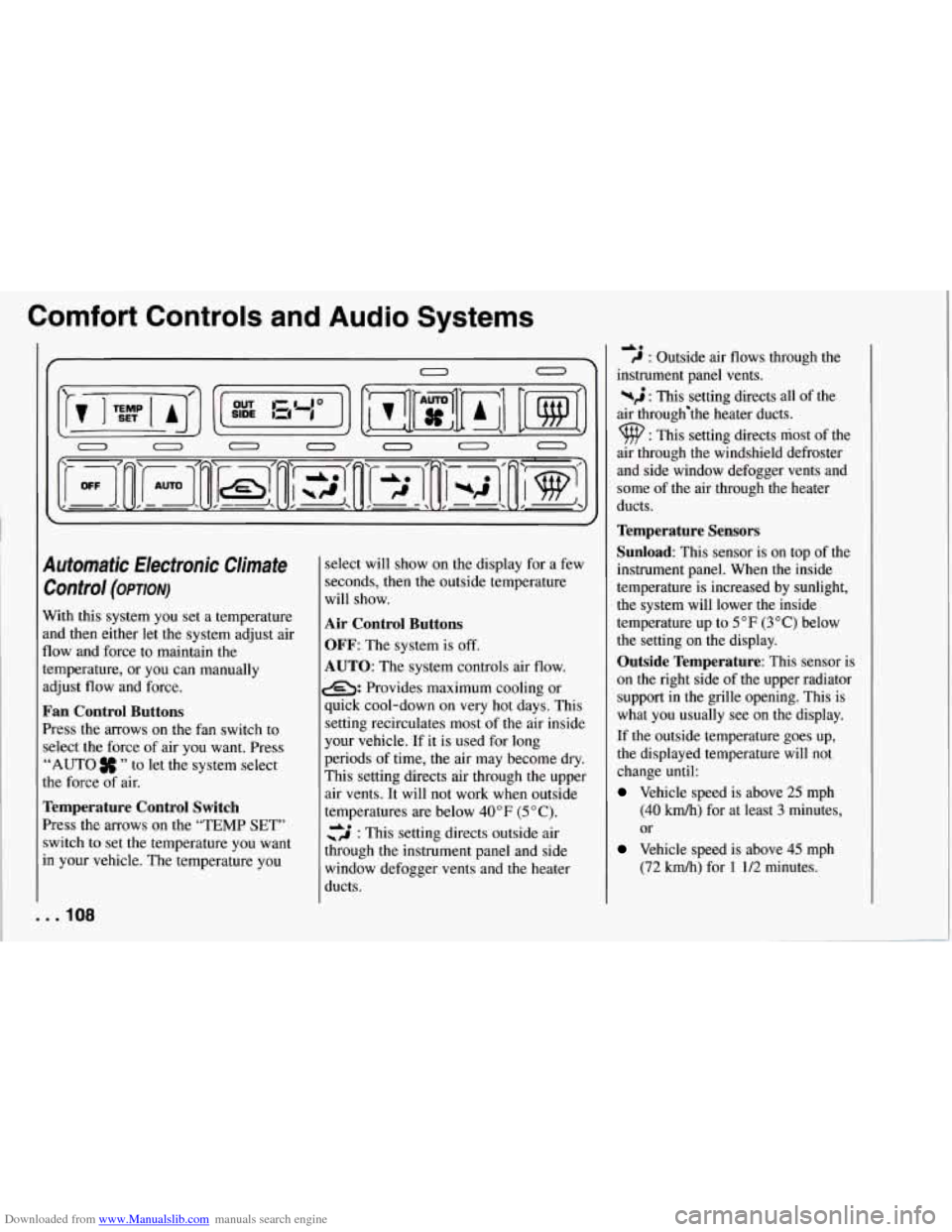
Downloaded from www.Manualslib.com manuals search engine Comfort Controls and Audio Systems
Automatic Electronic Climate Control
(OP~ON)
With this system you set a temperature
and then either let the system adjust air
flow and force to maintain
the
temperature, or you can manually
adjust flow and force.
Fan Control Buttons
Press the arrows on the fan switch to
select the force of air you want. Press
“AUTO
” to let the system select
the force of air.
Temperature Control Switch
Press the arrows on the “TEMP SET’’
switch to set the temperature you want
in your vehicle. The temperature you
. . .IO8
select will show on the display for a few
seconds, then the outside temperature
will show.
Air Control Buttons
OFF:
The system is off.
AUTO: The system controls air flow.
e: Provides maximum cooling or
quick cool-down on
very hot days. This
setting recirculates most of the air inside
your vehicle. If it is used for long
periods of time, the air may become dry.
This setting directs air through the upper
air vents. It will not work when outside
temperatures are below
40°F (5 “C).
cs : This setting directs outside air
through the instrument panel and side
window defogger vents and the heater
ducts.
40 C : Outside air flows through the
instrument panel vents.
%$ : This setting directs all of the
air through‘the heater ducts.
9 : This setting directs most of the
air through
the windshield defroster
and side window defogger vents and
some of the air through the heater
ducts.
Temperature Sensors
Sunload:
This sensor is on top of the
instrument panel. When the inside
temperature is increased by sunlight,
the system will lower the inside
temperature up to
5°F (3°C) below
the setting on the display.
Outside Temperature: This sensor is
on the right side of the upper radiator
support in the grille opening. This is
what you usually see on the display.
If the outside temperature goes up,
the displayed temperature will not
change until:
Vehicle speed is above 25 mph
(40 kmh) for at least 3 minutes,
or
Vehicle speed is above 45 mph
(72
km/h) for 1 1/2 minutes.
Page 110 of 274
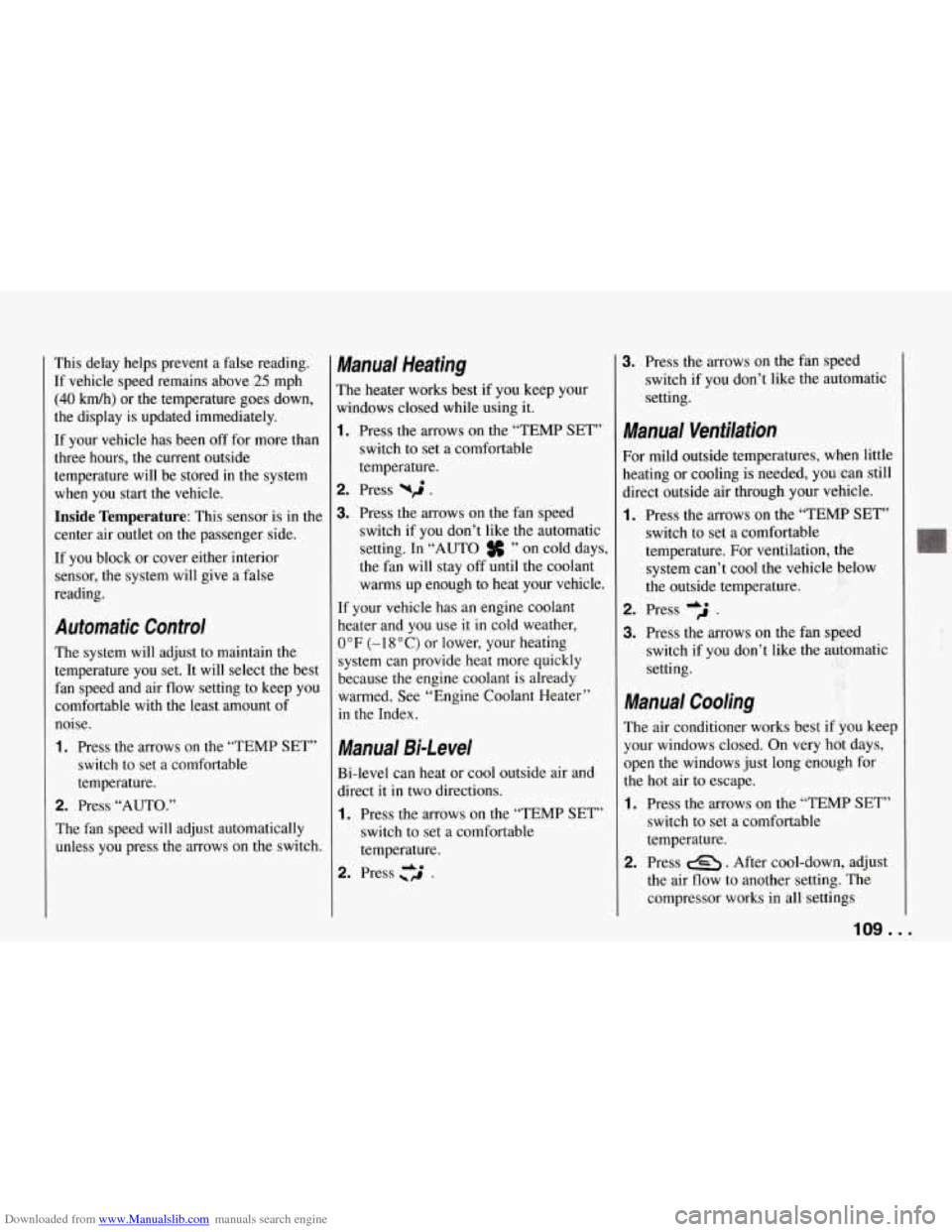
Downloaded from www.Manualslib.com manuals search engine This delay helps prevent a false reading.
If vehicle speed remains above
25 mph
(40 kmh) or the temperature goes down,
the display is updated immediately.
If your vehicle has been
off for more than
three hours, the current outside
temperature will be stored
in the system
when you start the vehicle.
Inside Temperature: This sensor is in the
center air outlet on the passenger side.
If you block or cover either interior
sensor, the system will give a false
reading.
Automatic Control
The system will adjust to maintain the
temperature you set. It will select the best
fan speed and air flow setting to keep you
comfortable with the least amount of
noise.
1. Press the arrows on the “TEMP SET”
switch to set a comfortable
temperature.
2. Press “AUTO.”
The fan speed will adjust automatically unless you press
the arrows on the switch.
Manual Heating
The heater works best if you keep your
windows closed while using it.
1. Press the arrows on the “TEMP SET”
switch to set a comfortable
temperature.
2. Press uj .
3. Press the arrows on the fan speed
switch if you don’t like the automatic
setting. In “AUTO
# ” on cold days,
the fan will stay off until the coolant
warms up enough to heat your vehicle.
If your vehicle has an engine coolant
heater and you use it in cold weather,
0 OF (-1 8 O C) or lower, your heating
system can provide heat more quickly
because the engine coolant
is already
warmed. See “Engine Coolant Heater”
in the Index.
Manual Bi-Level
Bi-level can heat or cool outside air and
direct it in two directions.
1. Press the arrows on the “TEMP SET”
switch to set a comfortable
temperature.
2. Press 3 .
3. Press the arrows on the fan speed
switch if
you don’t like the automatic
setting.
Manual Ventilation
For mild outside temperatures, when little
heating or cooling is needed, you can still
direct outside
air through your vehicle.
1. Press the arrows on the “TEMP SET”
switch to set a comfortable
temperature. For ventilation, the system can’t cool the vehicle below
the outside temperature.
2. Press dJ .
3. Press the arrows on the fan speed
switch if you don’t like the automatic
setting.
Manual Cooling
The air conditioner works best if you keep
your windows closed. On very hat days,
open the windows just long enough for
the hot air to escape.
1. Press the arrows on the “TEMP SET”
switch to set a comfortable
temperature.
2. Press a. After cool-down, adjust
the air flow to another setting. The
compressor works in all settings
109 ...
Page 137 of 274
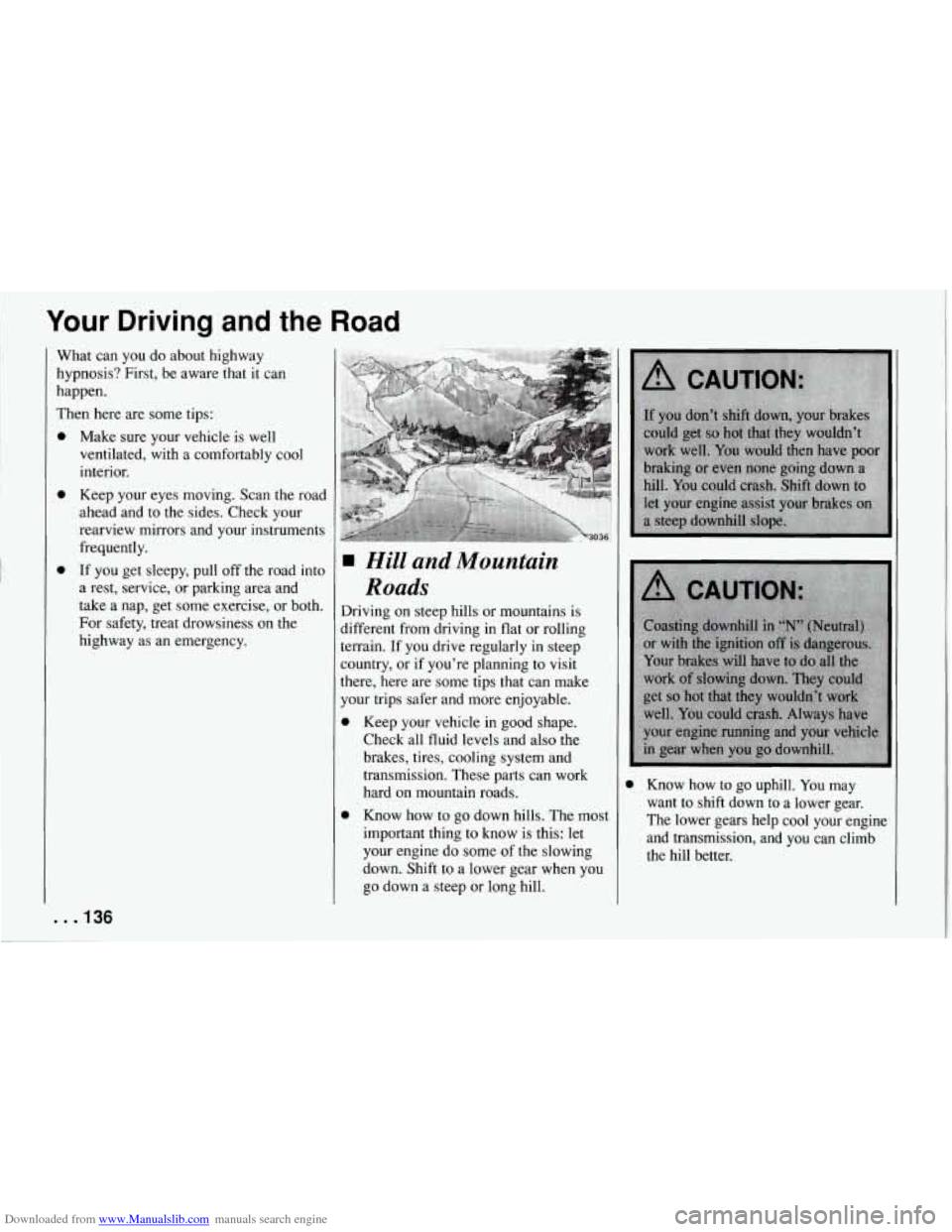
Downloaded from www.Manualslib.com manuals search engine Your Driving and the Road
What can you do about highway
hypnosis? First, be aware that
it can
happen.
Then here are some tips:
0 Make sure your vehicle is well
ventilated, with a comfortably cool
interior.
0 Keep your eyes moving. Scan the road
ahead and to the sides. Check your
rearview mirrors and your instruments
frequently.
0 If you get sleepy, pull off the road into
a rest, service, or parking area and
take a nap, get some exercise, or both.
For safety, treat drowsiness on
the
highway as an emergency.
Hill and Mountain
Roads
Driving on steep hills or mountains is
jifferent from driving in flat or rolling
terrain. If you drive regularly in steep
zountry, or if you’re planning to visit there, here are some tips that can make
your trips safer and more enjoyable.
Keep your vehicle in good shape.
Check all fluid levels and also the
brakes, tires, cooling system and
transmission. These parts can work
hard on mountain roads.
Know how to go down hills. The most
important thing to know is this: let
your engine do some
of the slowing
down. Shift to a lower gear when you
go down a steep or long hill.
0 Know how to go uphill. You may
want to shift down to a lower gear.
The lower gears help cool your engine and transmission, and you can climb
the hill better.
. . .136
Page 152 of 274
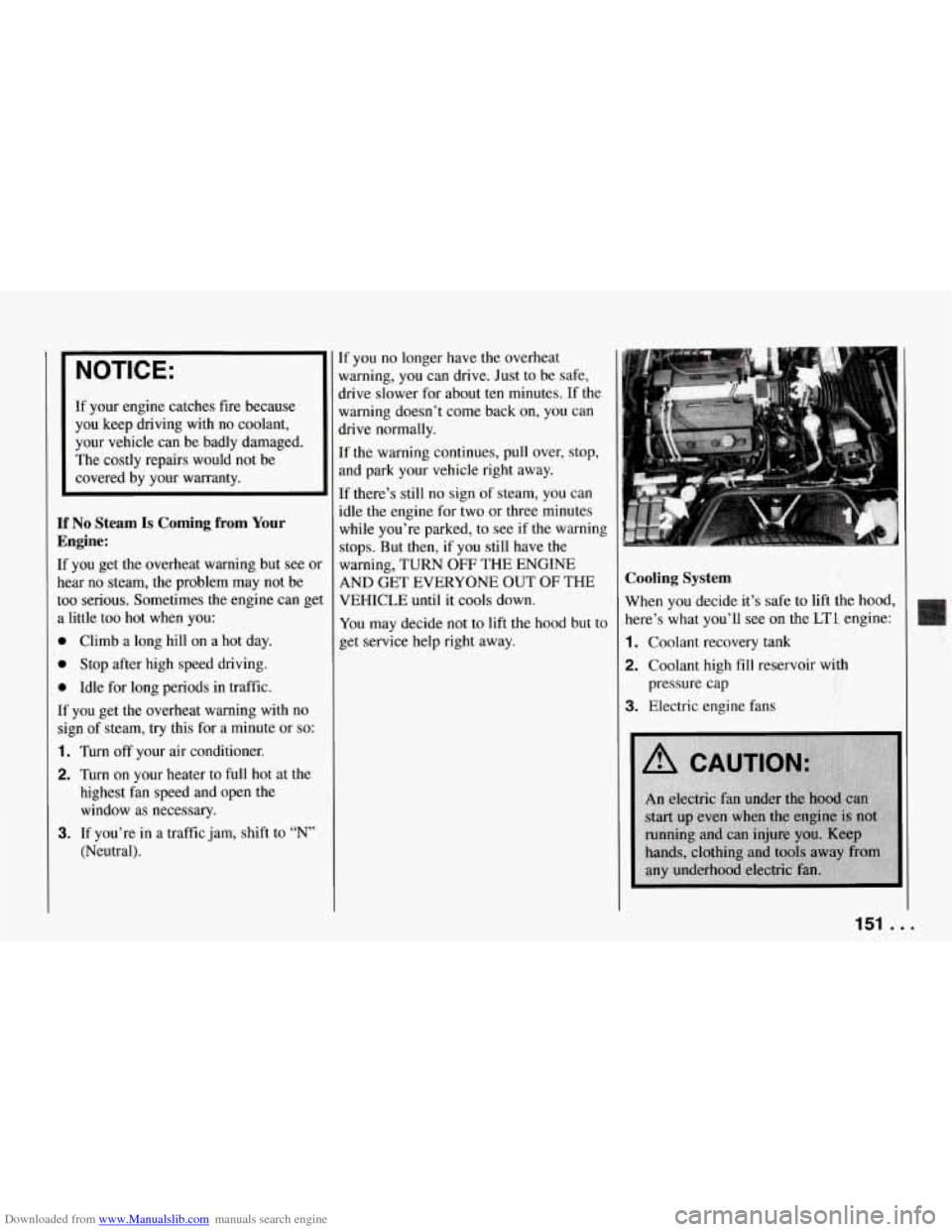
Downloaded from www.Manualslib.com manuals search engine NOTICE:
If your engine catches fire because
you keep driving with no coolant,
your vehicle can be badly damaged.
The costly repairs would not be covered by your warranty.
If No Steam Is Coming from Your
Engine:
If you get the overheat warning but see 01
hear no steam, the problem may not be
too serious. Sometimes the engine can ge
a little too hot when you:
0 Climb a long hill on a hot day.
0 Stop after high speed driving.
0 Idle for long periods in traffic.
If you get the overheat warning with no
sign of steam,
try this for a minute or so:
1. Turn off your air conditioner.
2. Turn on your heater to full hot at the
highest fan speed and open the
window as necessary.
(Neutral).
3. If you’re in a traffic jam, shift to “N’
[f you no longer have the overheat
warning, you can drive. Just to be safe,
hive slower for about ten minutes. If the
warning doesn’t come back on, you can
drive normally.
[f the warning continues, pull over, stop,
and park your vehicle right away.
[f there’s still no sign of steam, you can
idle the engine for two or three minutes
while you’re parked, to see if the warning
stops. But then, if you still have
the
warning, TURN OFF THE ENGINE
AND GET EVERYONE OUT
OF THE
VEHICLE until it cools down.
You may decide not to lift the hood but to
get service help right away.
Cooling System
When you decide it’s safe to lift the hood,
here’s what you’ll see on the LTl engine:
1. Coolant recovery tank
2. Coolant high fill reservoir with
3. Electric engine fans
pressure cap
151 ...
Page 153 of 274

Downloaded from www.Manualslib.com manuals search engine Problems on the Road
F
Cooling System
When you decide it’s safe to lift the hood,
here’s what you’ll see on the
LT5 engine:
1. Coolant recovery tank
2. Coolant high fill reservoir with
3. Electric engine fans
pressure cap
. . -152
If
the coolant inside the coolant recovery
tank is boiling, don’t do anything else
until it cools down.
When it is cool, remove the coolant
recovery tank cap and look at the dipstick.
The coolant level should be at or above
“COLD.” If it isn’t, you may have a leak
in the radiator hoses, heater hoses,
radiator, water pump or somewhere else
in the cooling system.
I NOTICE:
I
Engine damage from running your
engine without coolant isn’t covered
by your warranty.
If there seems to be no leak, check
to see
if the electric engine fans are running.
If the engine is overheating, both fans
should be running.
If they aren’t, your
vehicle needs service.
Page 154 of 274

Downloaded from www.Manualslib.com manuals search engine How to Add Coolant to the Coolant
Recovery Tank
If you haven’t found a problem yet, but
the coolant level isn’t at or above the
“COLD, mark, add a
50150 mixture of
clean water (preferably distilled) and a
proper antifreeze at the coolant recovery
tank. (See “Engine Coolant” in the Index
for more information about the proper
coolant
mix.)
NOTICE:
I
In cold weather, water can freeze and
crack
the engine, radiator, heater core
and other parts. Use the recom-
mended coolant.
When the coolant in the coolant recovery
tank is at or above the
“COLD” mark,
start your vehicle.
If the overheat warning continues, there’s
one more thing you can try. You can add
the proper coolant mix directly to the
coolant high fill reservoir, but be sure the
cooling system is cool before you do it.
153 ...